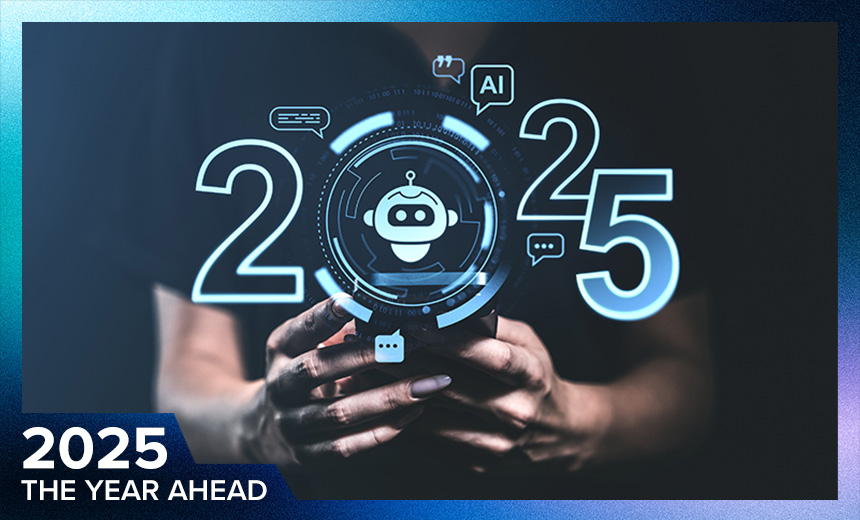Artificial Intelligence & Machine Learning
,
Next-Generation Technologies & Secure Development
2025 Is Likely to See Balanced Approach to AI Across Industries

The artificial intelligence landscape is set to transform in 2025 with pragmatic approaches to implementation replacing the experimental fervor of the past two years. This shift will span industries and developer ecosystems.
See Also: AI-Driven SOC Transformation with Cortex XSIAM
AI’s Role in Cybersecurity: A Double-Edged Sword
AI is both a defense mechanism and a weapon system in cybersecurity.
“We are in an era where AI systems will battle AI systems, with human security teams orchestrating strategies to maintain the upper hand,” said John Engates, field CTO at Cloudflare.
This arms race extends to open-source software as well, said Chris Hughes, chief security advisor at Endor Labs, adding that malicious actors increasingly turn their eyes to open-source AI libraries, models and platforms. Commercial AI vendors are “not immune either,” and require transparency in open source components in AI ecosystems, added the cyber innovation fellow at the Cybersecurity and Infrastructure Security Agency.
Disarming AI Models of Disinformation End
As AI systems become integral to the decision-making process, they run the risk of susceptibility to disinformation.
“In 2025, disinformation will go beyond the internet and social media and move to poison and taint AI models,” said Grant Bourzikas, chief security officer at Cloudflare. This contamination could damage critical applications, ranging from supply chain optimization to medical diagnoses. Robust data curation and verification processes would be key in addressing these challenges, he said.
AI-Powered Solutions for Healthcare’s Data Crisis
Healthcare is another sector on the cusp of AI-driven transformation, particularly in addressing its long-standing data fragmentation challenges.
Kevin Deutsch, general manager and senior vice president at Softheon, said that the “tipping point” for the industry will be in 2025 since more forward-thinking organizations will continue to focus on the formation of unified data models recognizing “Patient A is Patient A” across all touchpoints. The shift from those foundations will be directed in order to enable personalized healthcare experiences and benefit the care providers and patients alike.
Eric Prugh, chief product officer at Authenticx, said AI will be instrumental in identifying and summarizing trends related to complex healthcare challenges. By analyzing issues such as patient adherence and contact center quality, healthcare organizations can implement changes to drive positive outcomes and operational efficiencies.
Edge Computing: Unlocking AI’s Potential
The future of AI depends on edge computing, according to Cloudflare’s Engates. Bringing the computational resources closer to where they are needed reduces latency and makes real-time applications possible such as autonomous vehicles and interactive gaming.
“These innovations become possible when compute resources are strategically positioned near their point of use,” said Engates, adding that smart, distributed computing will be pivotal in unlocking AI’s “true” potential.
Reshaping the Developer Ecosystem
AI is also reshaping the developer ecosystem, making coding more accessible than ever before. Ricky Robinett, vice president of developer relations for Cloudflare, explained the role of these AI-powered coding assistants: “The time to ‘Hello, World‘ has shortened; it creates an incredible dopamine hit that sparks curiosity for people that might not have found coding even just a few years ago.” What’s happening is that those small business owners and also educators are able to deliver custom solutions without necessarily becoming programming experts.
Meanwhile, AI co-pilots are driving a shift toward microservices and modular applications. “Distributed, purpose-built services can be more easily understood within the context AI assistants can support,” said Rita Kozlov, vice president of product management at Cloudflare. This trend aligns with a broader industry pivot toward smaller, more efficient AI models and predictable pricing structures.
The Path Ahead: AI Pragmatism Takes Center Stage
As organizations move toward more scientific and value-conscious adoption of AI, 2025 is bound to be a year of pragmatism.
“Organizations will be more methodical in how they approach putting AI in front of customers, evaluating different approaches for different use cases,” said Kozlov. It will be less about seeking the largest, most expensive models and more about achieving measurable impact without unnecessary complexity.
The Harsh Reality: Innovate or Perish
The AI space will continue to challenge industries to innovate and adapt. Whether it’s the matter of healthcare data unification or edge-powered applications, the technologies shaping the year ahead will ride on the transformative power of AI as well as the responsibility that comes with it.
Within ten years, only two types of companies will remain, Bourzikas said: “Those that leveraged AI in order to innovate, and those that no longer exist.”
